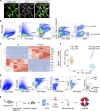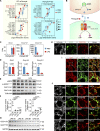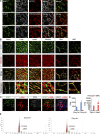Activating NO-sGC crosstalk in the mouse vascular niche promotes vascular integrity and mitigates acute lung injury
- PMID: 36350314
- PMCID: PMC9984546
- DOI: 10.1084/jem.20211422
Activating NO-sGC crosstalk in the mouse vascular niche promotes vascular integrity and mitigates acute lung injury
Abstract
Disruption of endothelial cell (ECs) and pericytes interactions results in vascular leakage in acute lung injury (ALI). However, molecular signals mediating EC-pericyte crosstalk have not been systemically investigated, and whether targeting such crosstalk could be adopted to combat ALI remains elusive. Using comparative genome-wide EC-pericyte crosstalk analysis of healthy and LPS-challenged lungs, we discovered that crosstalk between endothelial nitric oxide and pericyte soluble guanylate cyclase (NO-sGC) is impaired in ALI. Indeed, stimulating the NO-sGC pathway promotes vascular integrity and reduces lung edema and inflammation-induced lung injury, while pericyte-specific sGC knockout abolishes this protective effect. Mechanistically, sGC activation suppresses cytoskeleton rearrangement in pericytes through inhibiting VASP-dependent F-actin formation and MRTFA/SRF-dependent de novo synthesis of genes associated with cytoskeleton rearrangement, thereby leading to the stabilization of EC-pericyte interactions. Collectively, our data demonstrate that impaired NO-sGC crosstalk in the vascular niche results in elevated vascular permeability, and pharmacological activation of this crosstalk represents a promising translational therapy for ALI.
© 2022 He et al.
Conflict of interest statement
Disclosures: The authors declare no competing interests exist.
Figures















Similar articles
-
Pericyte signaling via soluble guanylate cyclase shapes the vascular niche and microenvironment of tumors.EMBO J. 2024 Apr;43(8):1519-1544. doi: 10.1038/s44318-024-00078-5. Epub 2024 Mar 25. EMBO J. 2024. PMID: 38528180 Free PMC article.
-
Modulation of nitric oxide-stimulated soluble guanylyl cyclase activity by cytoskeleton-associated proteins in vascular smooth muscle.Biochem Pharmacol. 2018 Oct;156:168-176. doi: 10.1016/j.bcp.2018.08.009. Epub 2018 Aug 10. Biochem Pharmacol. 2018. PMID: 30099008
-
Ablation of endothelial Pfkfb3 protects mice from acute lung injury in LPS-induced endotoxemia.Pharmacol Res. 2019 Aug;146:104292. doi: 10.1016/j.phrs.2019.104292. Epub 2019 Jun 2. Pharmacol Res. 2019. PMID: 31167111 Free PMC article.
-
Structure and Activation of Soluble Guanylyl Cyclase, the Nitric Oxide Sensor.Antioxid Redox Signal. 2017 Jan 20;26(3):107-121. doi: 10.1089/ars.2016.6693. Epub 2016 Apr 26. Antioxid Redox Signal. 2017. PMID: 26979942 Free PMC article. Review.
-
Structural Perspectives on the Mechanism of Soluble Guanylate Cyclase Activation.Int J Mol Sci. 2021 May 21;22(11):5439. doi: 10.3390/ijms22115439. Int J Mol Sci. 2021. PMID: 34064029 Free PMC article. Review.
Cited by
-
Smoking aggravates neovascular age-related macular degeneration via Sema4D-PlexinB1 axis-mediated activation of pericytes.Nat Commun. 2025 Mar 22;16(1):2821. doi: 10.1038/s41467-025-58074-0. Nat Commun. 2025. PMID: 40121188 Free PMC article.
-
Uridine Phosphorylase 1 as a Biomarker Associated with Glycolysis in Acute Lung Injury.Inflammation. 2025 Feb 19. doi: 10.1007/s10753-025-02270-z. Online ahead of print. Inflammation. 2025. PMID: 39969741
-
Macrophage-related inflammatory responses to degradation products of biodegradable molybdenum implants.Mater Today Bio. 2025 Jan 23;31:101519. doi: 10.1016/j.mtbio.2025.101519. eCollection 2025 Apr. Mater Today Bio. 2025. PMID: 39990739 Free PMC article.
-
Anti-Fibrotic and Anti-Inflammatory Role of NO-Sensitive Guanylyl Cyclase in Murine Lung.Int J Mol Sci. 2023 Jul 19;24(14):11661. doi: 10.3390/ijms241411661. Int J Mol Sci. 2023. PMID: 37511420 Free PMC article.
-
Uptake of H-ferritin by Glioblastoma stem cells and its impact on their invasion capacity.J Cancer Res Clin Oncol. 2023 Sep;149(12):9691-9703. doi: 10.1007/s00432-023-04864-2. Epub 2023 May 26. J Cancer Res Clin Oncol. 2023. PMID: 37237166 Free PMC article.
References
-
- Ahluwalia, A., Foster P., Scotland R.S., McLean P.G., Mathur A., Perretti M., Moncada S., and Hobbs A.J.. 2004. Antiinflammatory activity of soluble guanylate cyclase: cGMP-dependent down-regulation of P-selectin expression and leukocyte recruitment. Proc. Natl. Acad. Sci. USA. 101:1386–1391. 10.1073/pnas.0304264101 - DOI - PMC - PubMed
-
- Becker, E.M., Schmidt P., Schramm M., Schroder H., Walter U., Hoenicka M., Gerzer R., and Stasch J.P.. 2000. The vasodilator-stimulated phosphoprotein (VASP): Target of YC-1 and nitric oxide effects in human and rat platelets. J. Cardiovasc. Pharmacol. 35:390–397. 10.1097/00005344-200003000-00007 - DOI - PubMed
Publication types
MeSH terms
Substances
LinkOut - more resources
Full Text Sources
Molecular Biology Databases
Miscellaneous

